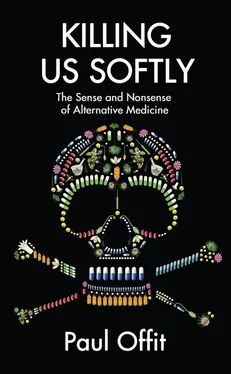On May 26, 1977, Franz Ingelfinger, the distinguished editor of the New England Journal of Medicine , published an editorial titled “Laetrilomania.” Ingelfinger wrote, “As a cancer patient myself, I would not take Laetrile under any circumstances. If any members of my family had cancer, I would counsel them against it. If I were still in practice, I would not recommend it to my patients.” Despite his personal feelings, Ingelfinger suggested a definitive study—one that would settle the argument once and for all. In December 1979, the FDA granted an “investigational new drug” license for laetrile, opening the door for a study. This was the first time in the history of the United States that the FDA had approved human testing of a cancer drug that had never been shown to work in experimental animals.
While researchers were designing Ingelfinger’s laetrile study, other events were working on Joey’s behalf. In July 1977, Senator Edward Kennedy of Massachusetts held a hearing to discuss the value of laetrile. Testifying in favor of the drug were San Francisco physician and laetrile proponent John Richardson, John Bircher Robert Bradford, and laetrile inventor Ernest Krebs Jr. Kennedy didn’t buy it, saying, “There isn’t a scintilla of evidence that [laetrile] provides any sense of hope in curing or preventing cancer.” During the hearing, representative Terrence McCarthy of Massachusetts was less politic. “The people selling laetrile are crooks, liars, and thieves,” he said.
Unfortunately, clear statements by the editor of the New England Journal of Medicine and Senator Edward Kennedy didn’t convince the courts that Joey Hofbauer had received inadequate care. On July 10, 1979, in response to the Saratoga County Department of Social Services’ final appeal, Judge Jasen ruled that he was “unable to conclude, as a matter of law, that Joseph’s parents [had] not undertaken reasonable efforts to ensure that acceptable medical treatment is being provided their child.” It was Joey Hofbauer’s last chance to receive the radiation and chemotherapy he needed. Jasen still considered laetrile, coffee enemas, pancreatic enzymes, and a “vaccine” made from bacteria in Joey’s urine to be “acceptable medical treatment.”
On July 10, 1980, ten-year-old Joey Hofbauer died of Hodgkin’s disease, his lungs riddled with cancer. Although Michael Schachter acknowledged that Hodgkin’s disease had killed Joey, he claimed partial success. “Most of the body was either free of Hodgkin’s or minimally involved,” he said.
Four months later, America’s most celebrated standard-bearer for laetrile, Steve McQueen, also died. After McQueen’s appearance on Mexican television, Cliff Coleman, a longtime friend, had paid him a visit. “I walked over and there was this skinny old man,” recalled Coleman. “No more than a skeleton with dark eyes and a matted beard, sitting swallowed up in an armchair.” McQueen told Coleman, “I can’t take it anymore.” One month later, McQueen was taken to a medical clinic in El Paso, Texas, where tests showed that cancer had spread from his lungs to his abdomen, liver, and pelvis. Within a few days, on November 7, 1980, during surgery to remove a massive abdominal tumor, Steve McQueen died of a heart attack.
One year after the deaths of Joey Hofbauer and Steve McQueen, cancer specialist Charles Moertel, of the Mayo Clinic in Rochester, Minnesota, led research teams at UCLA, the University of Arizona, and the Memorial Sloan-Kettering Cancer Center, in New York, in the clinical trial proposed by Franz Ingelfinger. They treated 178 cancer victims with laetrile and high doses of vitamins, finding that the combination didn’t cure, improve, or stabilize cancers. “Patients died rapidly, with a median survival of only 4.8 months,” they wrote. “It must be concluded that Laetrile [is] of no substantive value in the treatment of cancers. Further investigation or clinical use of such therapy is not justified.” Researchers also found that several patients had suffered symptoms of cyanide poisoning from laetrile. Within a year of the publication, laetrile sales dropped dramatically. In 1987, the FDA banned the sale of laetrile. (It can still be obtained from clinics in Mexico or illegally from the Internet. In recent years, more websites have appeared promoting the drug.)
In retrospect, the last best chance to save Joey Hofbauer had occurred in one court and one court only: Judge Loren Brown’s family court. This was the only time that cancer specialists had testified. Lawyers working on behalf of Joey had done their homework. The doctors and scientists presented by the state had published hundreds of papers, written book chapters on Hodgkin’s disease, chaired professional societies, headed research teams showing the value of radiation and chemotherapy, performed studies in experimental animals showing that laetrile didn’t work and was dangerous, or headed the FDA’s section on cancer treatments. They were, in short, the brightest, most accomplished members of their field.
The doctors and scientists offered by the Hofbauers also shared several characteristics: none were board-certified in oncology, hematology, or toxicology; none had ever published a paper in a medical journal; none had shown any reasonable evidence that their therapies worked; and most didn’t even have hospital privileges. That Brown could rule in favor of the Hofbauers’ choice to deny their son a proven, effective therapy is unconscionable. But an explanation can be found in the record of the trial. In the section titled “Findings of Fact and Conclusion of Law,” Brown wrote, “This court finds that metabolic therapy has a place in our society, and, hopefully, its proponents are on the first rung of a ladder that will rid us of all forms of cancer.” Brown believed that his small family court in Saratoga County had witnessed a miracle—a breakthrough that would soon turn cancer therapy on its ear. To Judge Brown, the notion that laetrile and coffee enemas could treat Joey Hofbauer wasn’t a matter of opinion; it was a “Finding of Fact.”
There was another force working against Joey Hofbauer in Judge Brown’s courtroom that day—a force far more powerful than clinicians like Michael Schachter or laetrile promoters like Ernest Krebs Jr. or ideologues like Robert Bradford. It was revealed during an exchange between the Hofbauers’ lawyer, Kirkpatrick Dilling, and Victor Herbert, a cancer specialist. Dilling was questioning Herbert about the value of bonemeal.
DILLING: Calcium, is that an essential nutrient?
HERBERT: Yes.
DILLING: Are you familiar with the fact that bonemeal is very high in calcium?
HERBERT: I’m familiar with the fact that bonemeal is a dangerous quack remedy because of its lead content and people have died from being given bonemeal instead of calcium properly in milk and milk products.
DILLING: Isn’t bonemeal widely available?
HERBERT: Certainly is, your organization pushes it.
Dilling froze. His organization? Herbert had revealed something that wasn’t evident to most in the courtroom that day—exactly who was paying for the Hofbauers’ defense. Recovering, Dilling went on the offensive. “I want to state for the record,” he said, “that I’m proud to represent the National Health Federation and I would appreciate it if the witness would keep his views to himself.”
The National Health Federation (NHF) is an organization that represents the financial interests of the alternative medicine industry. At the time of Joey’s trial, these therapies had become quite lucrative. Kirkpatrick Dilling was general counsel to the NHF. Against these powerful financial interests, Joey Hofbauer didn’t have a chance.
Michael Schachter was never held accountable for his treatment of Joey Hofbauer. On the contrary, since Joey’s death Schachter has thrived, directing the Schachter Center for Complementary Medicine, in Suffern, New York. In 2010, a promotional brochure claimed he “has successfully treated thousands of patients using orthomolecular psychiatry, nutritional medicine, chelation therapy for cardiovascular disease, and alternative cancer therapies.”
Читать дальше

![Джейн Остин - Sense and Sensibility [С англо-русским словарем]](/books/26612/dzhejn-ostin-sense-and-sensibility-s-anglo-thumb.webp)
![Edzard Ernst - Trick or Treatment. The Undeniable Facts about Alternative Medicine [Electronic book text]](/books/151762/edzard-ernst-trick-or-treatment-the-undeniable-fa-thumb.webp)









